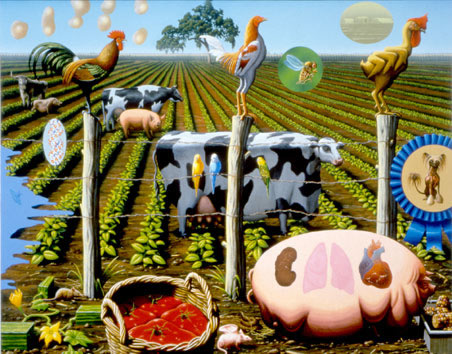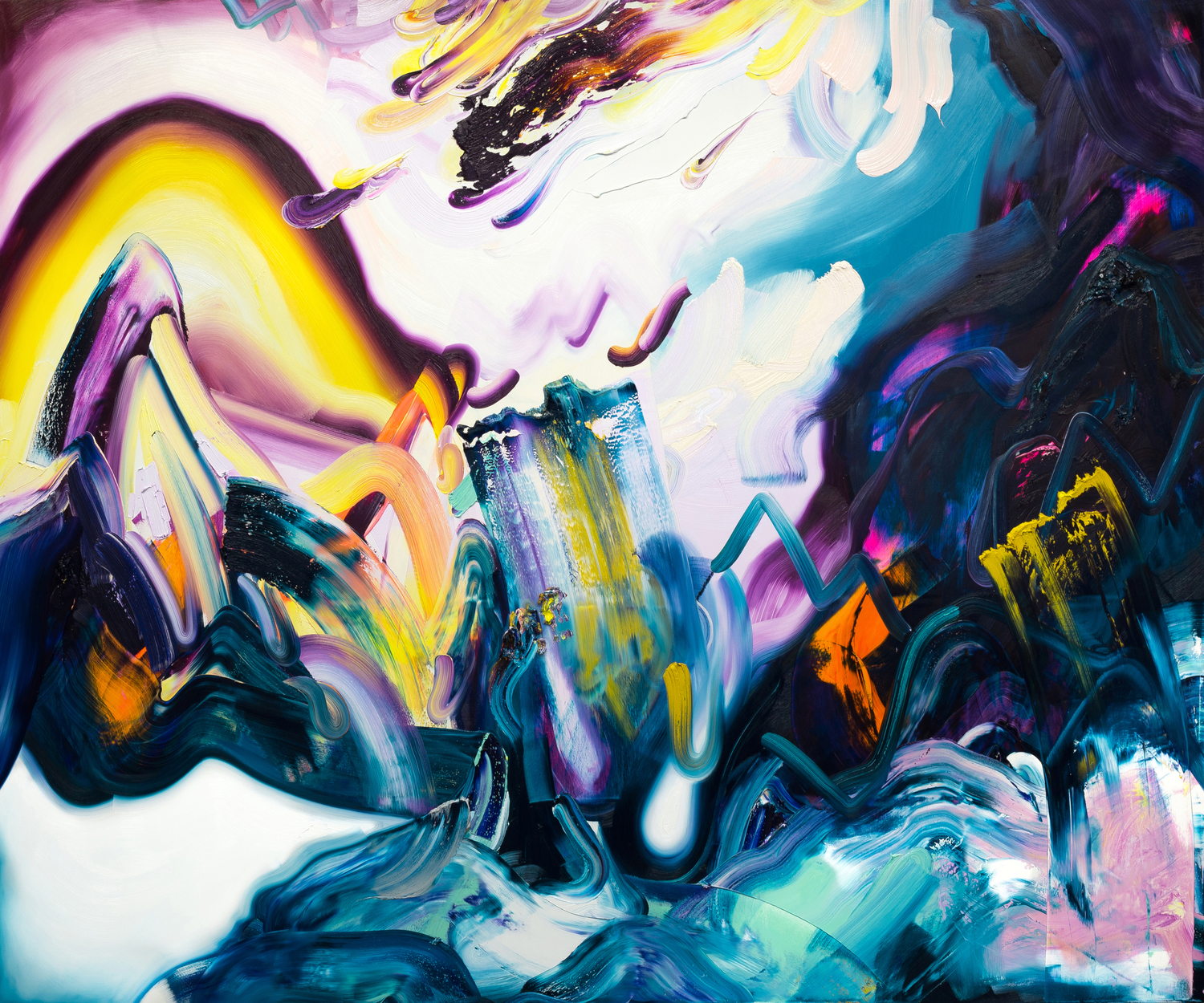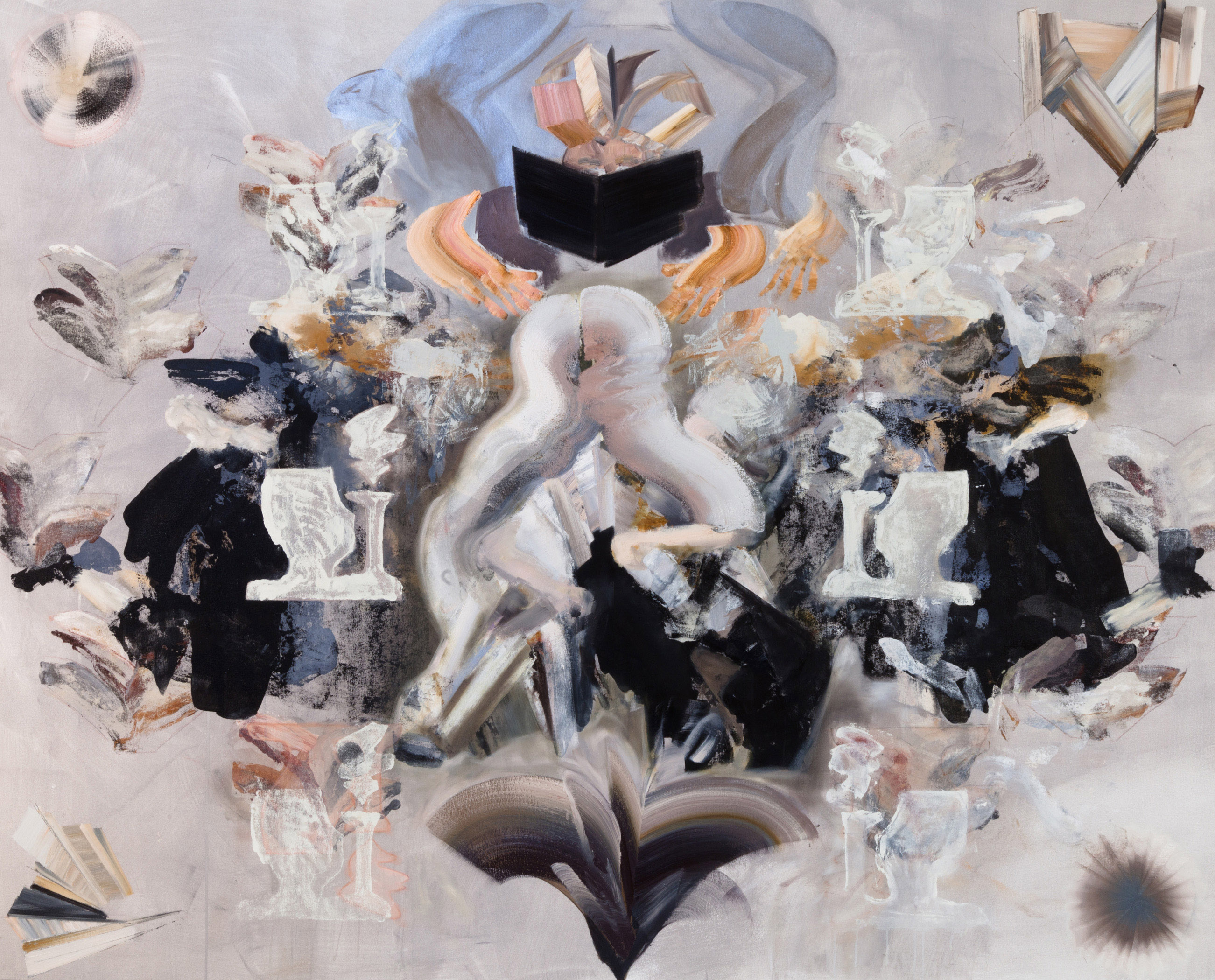
By Randy Gladman
Alexis Rockman sauntered up to our meeting spot on Canal Street, the sanguine spring in his step belying the bizarre state of Broadway, deserted except for about twenty police officers wearing flak jackets and carrying machine guns. The natural history painter’s studio is located in an area of Manhattan that was closed off to all nonresidents in the aftermath of the tragedy of September 11, Black Tuesday, and he arrived exactly on time to escort me into the war zone. Alexis Rockman sauntered up Broadway to our meeting spot on Canal Street, the sanguine spring in his step belying the bizarre state of Broadway, deserted except for about twenty police officers wearing flak jackets and carrying machine guns. The natural history painter’s studio is located in an area of Manhattan that was closed off to all nonresidents in the aftermath of the tragedy of September 11, Black Tuesday, and he arrived exactly on time to escort me into the war zone.
Rockman’s conspicuous optimism seemed comfortably reassuring as we chatted in his basement studio. The interview had been planned since before the attack occurred, and it was clear that the artist was not suffering from the confused emotions I was experiencing. So, following his example, I began with the plan of asking the kind of questions I would have asked had the towers not fallen.
Do you think of your paintings as science fiction, or as fiction, or science?
I think that in a classic sense what I have in mind, and what the viewer brings to the table, might be entirely different. But the things I’m interested in are how often science reminds us of our own constructs and fantasies about the world and how often science undermines those fantasies.
I think that science has always been treated with a level of suspicion. There is a level of intimidation that goes with the scientific community that alienates people in an unnecessary way. I’m trying to popularize these ideas. And that is something I might have in common with Stephen Jay Gould and Peter Douglas Ward. What ends up happening with a lot of scientific information is that it becomes relatively unavailable emotionally, so people have a very hard time understanding all the wonderful and interesting stories.
My art practice is to turn science inside out and roll around in it and make it almost indistinguishable from fiction. There is a paradox there that I’m eternally interested in.
In the new monograph of your work to be published next year, Gould praises your “ingenious and original effort to illustrate and overcome the overwhelming biases–political, sociological, psychological and innately wired–that we impose upon nature when we try to understand her ways.” How did he first learn of your work?
I stalked him … no, just kidding. I was introduced to him, I think, by (the famous 19th-century dinosaur painter) Charles R. Knight’s granddaughter. She was kind enough to show Gould some of my images and his response was positive enough for me to write him a letter.
How closely have you worked with him?
Never.
Does he own any of your work?
Yes. He owns the painting I made for him of three insects trying to mate with each other (The Hammock, 2000) and I did a piece called The Creationist Classroom (1998) that I gave to him as well.
Tell me about your stand against General Electric’s pollution of the Hudson River and the effort to get them to pay for its cleanup. Why did you decide to take up this issue?
I happened to meet Alex Matheson, the director of River Keeper, at a social event and he asked me whether I would be interested. I never say no to conservation requests from different groups. I feel it is the least I can do given the circumstances, especially since I proclaim to be so interested in it. I grew up in New York and the Hudson has always been symbolic of the history of this city. My mom is an archeologist and a Dutch Settlement specialist so the Hudson is important to her. It just seemed the right thing to do.
The current freak-out about stem cells fits into this general concern. Where do you stand on this issue?
It’s true I have a project planned that will deal with how bodies might be transformed for athletic purposes. I am interested in reminding people that we have a biological contract, as does every other organism on this planet. One of the things that I struggle with is reconciling the idea of my own
mortality with the tremendous pressure that this culture puts on us not to get sick or show any sign of weakness, let alone die. In terms of stem cells, it seems to be the richest opportunity for promoting human health and life.
What about the potential for abuse?
I think stem cell research absolutely has to be done. It is tremendously frightening but it is also one of the few hopes for conservation because it really does make the best use of available resources. All my scientist friends are mostly concerned about fresh water. Global temperature rise and lack of fresh water are serious issues, so everything else pales in comparison, including the cloning issue. Clones need water too, you know.
You often mention men like Darwin, Beebe, Attenborough. Do you consider yourself a naturalist, or does the heavy dose of parody in the works prevent this?
I consider myself a naturalist, absolutely. The problem is that now, after this terrible week we just had, I find the very ideas of parody and irony totally idiotic. The nature of this painting I am currently working on (Sea World) is now dated and inappropriate perhaps. It seems like a “pre-World Trade Center disaster” painting all of a sudden. Now I want to paint lyrical beautiful things with complete earnestness. I’m in shock. Irony, you know, is a distancing mechanism for pain.
Mark Dion, with whom you traveled to the tropics, says you portrayed yourself and the members of your expedition as “Ugly American Yahoos” (New York Times Magazine, October 2000). Is work like your Expedition series (1999- ) commenting on shows like Survivor and The Amazing Race? It seems to fit into a Pop niche between such programs and Attenborough’s Trials of Life.
I’d have to say that I started that project a long time before any Survivor fad happened and I don’t think I would have done it in the same way had I known that that was going to happen. In retrospect, using myself and my friends was only a way of sending up those idiotic projects. But they didn’t exist in the same way then. Had I known, I would never have gone to Guyana. I think shows like that are on their way to extinction now, given the recent events. They have a market when there is a level of safety and you are looking for a type of sanctioned, institutionalized danger. The terror that we have all collectively witnessed via the media these past weeks makes those shows seem incredibly stupid and dull.
Where do you think your paintings fit in the current contemporary art scene? You have said the works, specifically those from the Expedition series, are popular natural history paintings. Many of the visual elements are derived from popular science magazine illustration. Do you consider the works to be Pop natural history?
Sure. We all initially arrive at what we do intuitively and then try to make sense of it, if it does at all. I’ve always contended that I’m a Pop artist because I’m interested in ideas and information that are available through pop culture.
Damien Hirst deals with a similar fascination for the physical world, but his interest lies in other areas of science, specifically the medical service and pharmaceutical industries. Are there parallels between his work and yours?
I think the profound difference between what he does and what I do is that my Protestant ethics forces me to seek the history and meaning of these cultural images, whereas Damien is concerned with how they are perceived instantaneously, almost as spectacle. I don’t mean this as a value judgment. He’s not interested at all in the history of pharmaceutical design, but rather in what it looks like and how it is consumed. Or how cool it is. That’s not to say that he isn’t interested in history, but I think he is much freer than I will ever be in his ability to absorb things and spew them
out instantaneously.
The techniques you employ are similar to those used in photorealism. What do you think of the Louis K. Meisel circle of photorealists?
They’re a guilty pleasure. There is some cool shit happening in those paintings, I would never frown upon that. I think there is a tremendous amount of shame and ambivalence about how much fun people have looking at them and how much that shame pisses other people off. Look at Norman Rockwell. Here is someone who is incredibly important in how we formulate our cultural identity. No one can disagree with this. Whether his work is interesting to them or not is a different story, but it certainly shows how our culture collectively imagines its history through fantasy.
There is a reaction, in some circles, against your work just as there is
against Rockwell’s. Do you think there is a parallel?
I’m not interested in proselytizing how important American culture is, or in reinforcing a conservative political agenda. Do people get upset if they see something that is painted in a credible, veristic, or skillful way? I don’t know, I don’t care about those kinds of arguments.
How did you feel about the 1999 Vogue article that portrayed you as the Über-chic artist? Artists aren’t usually portrayed as gloriously handsome. The article seemed to focus more on your personal history–drug-abusing father, nervous breakdowns, the scary sexiness of your work. Do you enjoy that kind of cult-of-personality examination?
When you do a project like that you have to understand that you are dealing with a fashion magazine and they have an agenda to sell fashion accessories. They are trying to turn whoever you are into someone who will help them do that. If you get upset over it, then you should not really do crossover press because your expectations are going to be completely inappropriate. The whole process is humiliating, embarrassing, and stupid on a certain level. It is also exhilarating and fun. I spend my whole life in this basement studio alone. I don’t find that particularly glamorous, do you?
I had an experience with W magazine this summer where I was misquoted and that angered me. They did an article on Sullivan County, where my wife recently opened a restaurant, and, unbeknownst to us, approached it with the angle that “New York hipsters go and straighten out the Deliverance hick motherfuckers.” That is really not how we felt about it at all. And then, to add insult to injury, the writer, without fact-checking, wrote that we had accused our neighbor of shooting our cat. He made that up. That annoyed me tremendously.
You grew up in and around the American Museum of Natural History. Obviously this had an affect on your work. If you had spent your childhood hours of freedom elsewhere, like in the suburbs of Memphis working on muscle cars, do you think you’d still have turned out to be an artist?
If I grew up in the country, I’d be painting buildings or hard-edge abstraction, right? You always want to be somewhere else, isn’t that the human condition?
Is that why you rarely, if ever, include your own environment in your work? You are a born-and-raised Manhattanite. Is the absence of this island a reaction to its near total lack of natural significance?
I was recently asked to participate in a show at Snug Harbor Cultural Center in Staten Island about the Fresh Kills landfill. I have done a number of drawings over the years that I consider to be travel drawings that were either done on-site or very soon after I got back, so that they were associated with traveling to the destination. So I felt it was perfectly appropriate to do a series of drawings that describe some of the plants and animals that have been able to make a living in what we consider to be the most degraded of situations. In some ways I have represented New York over the years. But because I have spent so much time within a one-block radius, more or less, I have an urge to travel in my own mind.
I’m curious about your reaction to the recent events in New York. How do you think the world has changed? Do you think these changes are going to appear in your work? Do you think of moving away from New York?
The thing that I’m really worried about is that during times of crisis the issues that are even more important than national security, such as global climate change, get pushed into the background. And I find that more alarming than anything else because it shows how people in this culture consider concerns like those to be luxuries. No one quite understands what an increase in sea level of three inches will do to Miami, for instance. Humans are seasonal. It is tough for people to imagine beyond Christmas right now, let alone five or ten years.
How is this war, or whatever it turns out to be, going to affect the progression of contemporary art?
Lyricism and the sublime seem like wonderful directions to go in right now. Irony seems revolting. But what the fuck do I know? I’m in a goddamn basement listening to NPR all day. I don’t want to have anything to do with reality. I’m terrified to read the newspaper. So I tell stories. I’m a history painter. I don’t know if I relate the future or the past.
This is an edited version of the interview recorded on September 21, 2001 in the artist’s TriBeCa studio.
By Randy Gladman. Originally published in ArText Magazine, Spring 2002

